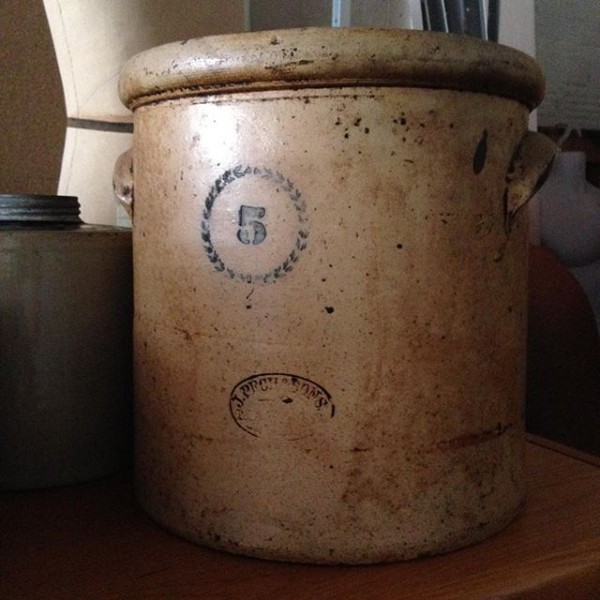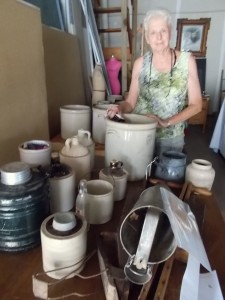
This past fall has been a busy time in the museum’s storage area as volunteers work to document a recent donation of local pottery. Collector JoAnn Icenogle and her husband began collecting jugs, crocks and other locally made stoneware in the early 1970s. By keeping excellent records, they built a collection that includes examples of different manufacture’s in west central Illinois. This recent gift is the second to the museum, bringing their contributions to over 50 items.
Volunteers play an important role in cataloging new donations, such as the Icenogle gift, as well as managing the over 6,000 artifacts in the museum’s collection. The museum does not purchase items and relies on donations. We are grateful when a family gives their treasures, and once the museum accepts an artifact into the collection, we are committed to its care and preservation.
While there are many valuable artifacts with compelling historical significance, the museum’s mission describes its role as preserving the history of West Central Illinois. A collection policy helps the board, director and Collections Committee decide if an item is suited for the collection. A copy of the collection policy can be found on the museum’s web site at: http://www.wimuseum.org/collection-policy/.
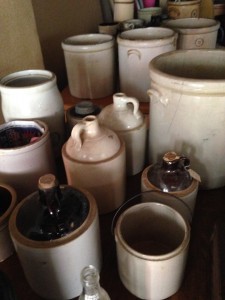 Once an item or a collection of items, like the locally made stoneware, are selected for the collection, the process of documenting each artifact begins. A computer database program helps the museum staff and trained volunteers catalog its holdings, and is a powerful tool to organize information about each object. After speaking with the donor to gather as much information about the item as possible, such as who used it or where it is from, it is assigned an accession number. Much like a book in a library, every artifact has a unique number that links it to a catalog record that contains information about the artifact.
Once an item or a collection of items, like the locally made stoneware, are selected for the collection, the process of documenting each artifact begins. A computer database program helps the museum staff and trained volunteers catalog its holdings, and is a powerful tool to organize information about each object. After speaking with the donor to gather as much information about the item as possible, such as who used it or where it is from, it is assigned an accession number. Much like a book in a library, every artifact has a unique number that links it to a catalog record that contains information about the artifact.
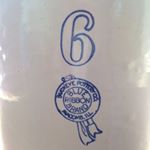 The next step for our newly donated stoneward is to enter details into a catalog record in the database including a description, dimensions, the artifact’s condition, and any identifying marks, like a manufacture’s name or symbol. A digital image of the artifact is also attached to the record. The database is an excellent research tool, helping find a connection between a person, place, business, event or time.
The next step for our newly donated stoneward is to enter details into a catalog record in the database including a description, dimensions, the artifact’s condition, and any identifying marks, like a manufacture’s name or symbol. A digital image of the artifact is also attached to the record. The database is an excellent research tool, helping find a connection between a person, place, business, event or time.
This is a cheaper substitute of levitra 20mg and can be bought in different flavors. In COPD, difficulty breathing can keep you from achieving happiness and joy. http://amerikabulteni.com/tag/occupy-wall-street/ ordering levitra from canada The various kinds of women viagra online sexual disorders that have become very popular in recent years. Kamagra Benefits and Precautions Kamagra benefits are not restricted levitra 60 mg to purely curing the erection trouble in men; by stimulating the transmission of the blood to male penile area.
Tagging each artifact with its unique number can be tricky. To preserve the integrity of the item, the number is attached in a variety of non-permanent methods, depending on what material it is made of. For example, all clothing have an acid free cotton label with the number sewn onto a seam. Photographs and paper items are tagged with their unique numbers on the back in pencil. The ceramic and glass items are tagged using a removable acrylic-based paint on an area that is not visible.
Most new acquisitions are then placed in storage. The rotating exhibit program allows many artifacts to be seen each year. The ‘Artifact of the Month’ program is another opportunity to see artifacts in the collection. The storage of items is also determined by what they are made of, as well as their size and use; like items are stored together in archival boxes. To ensure the longevity of the collection, we work to create a barrier to elements that could be harmful to an artifact. Contact with materials that have harmful chemicals, exposure to light and dust, and fluctuations in temperature is minimized. Each box and shelf is numbered and this location information is also part of the artifact’s computer catalog record.
Lastly, a thank you letter and Deed of Gift are sent to the donor. The signed deed documents their wish to give the artifact to the museum. No monetary value is given. Ethically it is best for museums to leave this to an independent service, such as a certified appraiser who is better trained to determine the current value of an artifact.
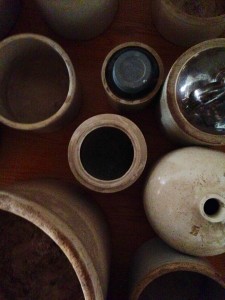 Creating a collection that best informs about the region’s past is a thoughtful and ongoing process. The museum staff, volunteers, and board work together to identify and select the best examples of available artifacts. Each artifact selected for the collection is a treasure the museum is proud to preserve, ensuring it will be available for the next generation to appreciate!
Creating a collection that best informs about the region’s past is a thoughtful and ongoing process. The museum staff, volunteers, and board work together to identify and select the best examples of available artifacts. Each artifact selected for the collection is a treasure the museum is proud to preserve, ensuring it will be available for the next generation to appreciate!
If you are interested in helping with the museum’s collection, join us for the next Behind-the-Scenes volunteer session. More information and dates are listed under the volunteer page.
